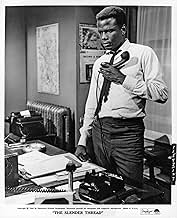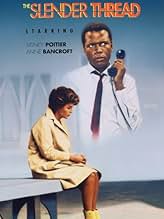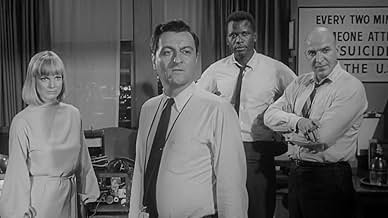अपनी भाषा में प्लॉट जोड़ेंCollege volunteer Alan Newell is working alone at the crisis center one evening when he receives a telephone call from suicidal caller Inga Dyson, who has swallowed a bottle of sleeping pill... सभी पढ़ेंCollege volunteer Alan Newell is working alone at the crisis center one evening when he receives a telephone call from suicidal caller Inga Dyson, who has swallowed a bottle of sleeping pills. Can Alan save her?College volunteer Alan Newell is working alone at the crisis center one evening when he receives a telephone call from suicidal caller Inga Dyson, who has swallowed a bottle of sleeping pills. Can Alan save her?
- निर्देशक
- लेखक
- स्टार
- 2 ऑस्कर के लिए नामांकित
- 2 जीत और कुल 4 नामांकन
- Doctor Morris
- (as H.N. Wynant)
- Patrolman Steve Peters
- (as Robert Hoy)
फ़ीचर्ड समीक्षाएं
Anyway, for his debut film, he settled on an intimate melodrama – shot on location in glorious black-and-white (incidentally, all his subsequent work would be in color). The plot is simple: Sidney Poitier is a student who works nights at a Seattle Crisis Clinic; on one occasion, a call comes in where a wealthy socialite at the end of her tether (Anne Bancroft) declares she has deliberately overdosed on barbiturates! She phoned not so much because she wanted help but rather so that someone will know of her outcome; Poitier, however, determines to keep her on the line – while he sets in motion a complex operation in order to trace Bancroft’s whereabouts and save her life.
For about the first third of the film, Bancroft barely appears: we only hear her world-weary voice booming across the room at the clinic, Poitier having switched the call to the loudspeaker; eventually, she starts to let her hair down and, in intermittent flashbacks, we see her movements during the last few days (which boils down to her alienation from familial cords due to a past mistake which has come back to haunt her). While this was certainly a way to do it, I’m baffled as to why we never cut to where Bancroft is now until the last act: consequently, we have to contend with a fair bit of padding during the ‘re-enactments’ (which could have easily been covered via dialogue delivered by the heroine)! That said, I guess it was a conscious decision on Pollack’s part to ‘open up’ the drama (not merely to include other characters – most prominently, Steven Hill as the woman’s husband – but also to utilize a number of exteriors, where he was able to exercise a keen eye for realistic detail).
Still, the film compels attention despite an essentially contrived central situation: for instance, at this point, it’s best not to go into how Bancroft manages to remain lucid for so long or, even more importantly, why she just doesn’t hang up on Poitier; and what about the plausibility of the latter’s temper-tantrums (to the exasperation of clinic psychiatrist Telly Savalas!) to coerce the woman into reacting, thus hanging on to life in spite of herself? But that’s Hollywood for you…and, in a talky film such as this, the emphasis is on the writing (by Stirling Silliphant) and the acting (Bancroft is typically excellent and Poitier’s contribution, amounting to a variation on his PRESSURE POINT [1962] role, just as good if slightly overstated in the long run). Even so, as a counter-balance to the ongoing histrionics, reasonable suspense – aided by up-to-date methods of detection – is generated throughout by the race-against-time to locate Bancroft.
At the end of the day, THE SLENDER THREAD emerges as a quite impressive (and generally still powerful) first outing – recalling the gritty work of many a contemporary film-maker who, like Pollack, had emerged from TV.
It was a terrific suspense movie that had the added benefit of showing Poitier in a totally race-neutral role as young psychology student Alan Newell who is volunteering at the local suicide hotline crisis center on a night that he has every reason to believe will be quiet...and then Inga Dyson (Ann Bancroft) calls him. She has just taken a bottle of barbiturates, does not want to be rescued, but does want to talk. So Alan has to keep his cool and keep Inga on the line long enough to be found, and she only has about 90 minutes to live.
What makes this movie totally anachronistic today is that the entire plot centers around a coordinated effort by scores of public servants in Seattle to trace Inga's phone number and save her before the pills do their job. Of course it would take about 10 seconds for the line to be traced today, which would kind of do away with the suspense.
The suspense is that her call COULD be traced, but it requires the huge telephone company building with countless thousands of connecting plugs and wires that had to be narrowed down, plus the police and fire departments and the State Department of Motor Vehicles, in order to locate the caller's number and where she was calling from. It was like a giant public works department that gave employment to pretty much every proactive player we see in the movie.
In the character development department we have a conversation between Alan an Inga in which we see how she got to the point of despair. It is one part of unforgiveness on her husband's part for a deed done before they were ever married, too much time on Inga's hands one day as the husband continues to stay emotionally detached from her as though she is some unclean thing, the fact that she wanted to talk to somebody about how she felt but could find nobody who would, and the final straw involves the death of an injured bird that is regarded callously by those around her while she tries to help.
In addition to Poitier and Bancroft, Steven Hill gives a chilling and highly credible performance as the unforgiving husband who's driven Bancroft to her suicide attempt. He's such a creepy character that he makes us almost want to force him to swallow those pills instead, and that's a sign that he plays the part to perfection.
Highly recommended because the emotions still ring true even if the technology is long gone.
Visuals aside, this is a great film. Again, dealing with some rather dark issues. The scene where Anne Bancroft comes home and sees her husband in the living room looking depressed...you don't know if he's having a psychotic episode, has lost his job or is on LSD. Anne Bancroft, overall, is a disturbing character. Perhaps more disturbing is that she would play another tragic character two years later - Mrs. Robinson, in The Graduate. Sidney Poitier is in usual form - the studious, morally-superior black in a predominantly white setting. I like what someone else here said - that the film very subtly has a subtext on race (how could a 1960s film showing blacks and whites in the same frame not? How could we as Americans not read race into the film?) while never dealing with race explicitly. This is actually one reason I think Sidney Poitier's characters and films are an important, and yet lost, representation of race relations. For all the flack that he got in the racially charged mood of the 1960s as an assimilationist good black who whites could accept, especially as he was the first black protagonist in films (it didn't help that he was West Indian, having grown up in the Bahamas). to me I still see some kind of Caribbean AND Black persona in his characters which I think he 'sneaks in' in subtle ways. His classic move is some breaking point at which he can't take any more -- whether its racial bigotry, disrespect for authority, or something else -- and he delivers some great speech of moral indignation. He does it in 'pressure point', in 'to sir with love', 'in the heat of the night', and maybe a few others. It may be pretentious at times, but this 'style' disappeared after the late 60s as blaxploitation with its overly masculinized and violent characters became the dominant representation in film.
Anyway, all the political and social analysis aside, this is really a great film.
Although not a true film noir; the black and white filming for me adds to the total involvement of the viewer and gives a heightened perspective to the whole cinema outing.
I suggest the film highly. The interactions between cast are worth the view.
क्या आपको पता है
- ट्रिवियाThis film shows the tedious process in 1965 of what was required in tracing a telephone call on actual central office equipment that was state of the art such as number 5 cross bar and step-by-step electro/mechanical equipment. It was filmed in central offices of the old Northwest Bell Telephone company which as of 2010 is now Century Link. Modern telephone switching equipment can trace a call in less than a minute or even 30 seconds.
- गूफ़After Inga attempts suicide by drowning herself in the bay, she arrives at hospital with perfectly styled hair.
- भाव
Mark Dyson: [to Inga] Do you think that not getting caught in a lie is the same as telling the truth?
- कनेक्शनFeatured in The Directors: The Films of Sydney Pollack (2000)
टॉप पसंद
- How long is The Slender Thread?Alexa द्वारा संचालित
विवरण
- चलने की अवधि
- 1 घं 38 मि(98 min)
- रंग
- ध्वनि मिश्रण
- पक्ष अनुपात
- 1.85 : 1





































